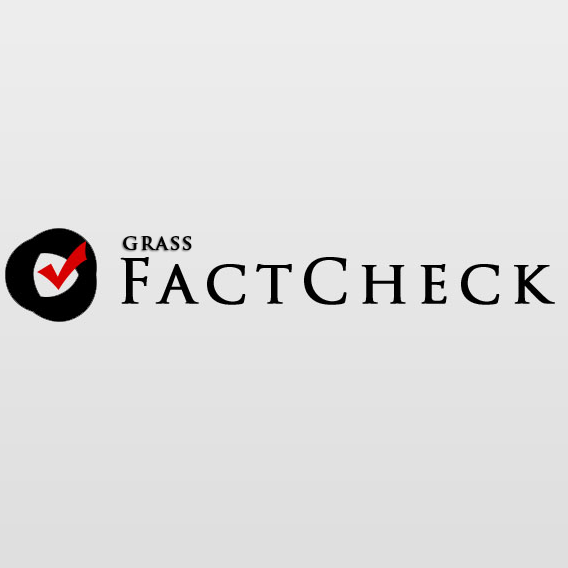Paata Kvizhinadze: “The economy will reach GEL 103 billion this year — four times higher than in 2012.”
Verdict: FactCheck concludes that Paata Kvizhinadze’s statement is HALF TRUE.
The GDP in current prices totalled GEL 27.9 billion in 2012 whilst the 2025 forecast is 3.7 times higher at GEL 103 billion — but this increase reflects only the nominal figure. Consumer prices have risen by 68% since 2012. Accordingly, the real growth rate drops significantly when measured in constant prices, accounting for inflation. The economy will have grown from GEL 36.2 billion to GEL 71.6 billion in constant 2019 prices.
Comparing the GDP per capita in USD with 2020 is also misleading. Besides the fact that 2020 is not a relevant base year — as the growth in 2021 mainly stemmed from reopening businesses closed during the pandemic — inflation and exchange rate fluctuations remain a challenge. The average exchange rate against USD was 3.11 in 2020 whilst in January-May 2025 it is 2.79. Thus, although the GDP per capita is set to rise from USD 4,300 to USD 9,900 between 2020 and 2025 (based on the projection for 2025), if calculated in the national currency and at constant prices, the increase is from GEL 12,500 to GEL 19,400.
The country’s total economy for 2025 should have grown by 300% as compared to 2012 and the GDP per capita by 130% as compared to 2020, according to Paata Kvizhinadze. However, the real economy will have grown by 97% as compared to 2012 whilst the GDP per capita’s growth would be 54% as compared to 2020 based on available official data.
Whilst the nominal figures are more or less correct, ignoring inflation and exchange rate shifts, which would halve the real growth rate, FactCheck concludes that Paata Kvizhinadze’s statement is HALF TRUE.
Analysis
Commenting on the economy, Paata Kvizhinadze stated: “We expect a high economic growth this year as well, reaching GEL 103 billion, which is four times higher than in 2012. The GDP per capita will exceed USD 10,000 this year (2020 — USD 4,300).”
The GDP at current prices totalled GEL 28 billion in 2012 and GEL 92 billion in 2024. The projection for 2025 is GEL 103 billion — 3.7 times higher.
The GDP calculated at current prices does not account for inflation which is a significant factor. An increase in income from GEL 100 to GEL 200 for an individual does not mean they are twice as well-off; what matters is how many goods and services could be purchased for GEL 100 in the first year and for GEL 200 in the second. The same principle applies to the overall economy. If a country still produces 100 loaves of bread, but the price of a loaf rises from GEL 1 to GEL 1.5, the nominal economy grows by 50% whilst the real economy does not grow at all. In theory, a country’s GDP in local currency can soar whilst the real economy contracts under hyperinflation. Despite a 6.3% decline in 2020, the nominal economy still grew slightly — from GEL 49.7 billion to GEL 49.8 billion.
To determine how much the economy has actually grown over time, the GDP must be calculated at constant prices or GDP growth rates must be multiplied sequentially.
The GDP rose from GEL 36.2 billion to GEL 67.5 billion between 2012 and 2024 in 2019 constant prices. The 2025 budget is based on a 6% growth rate which means that the GDP in 2019 prices will reach GEL 71.6 billion — twice the 2012 level. In other words, the real economy will have grown by 97% in 2025 as compared to 2012, not by 300%.
Graph 1: Gross Domestic Product (GEL Billion)
Source: National Statistics Office of Georgia, Ministry of Finance
The economic growth rate reached 9.8% in the first quarter. The GDP in constant 2019 prices will reach GEL 74.1 billion if this rate holds for the full year — 105% higher than in 2012. Even then, the gap with the claimed 300% growth remains significant.
An average annual GDP growth rate of 11.2% would be needed to quadruple the economy in 13 years whilst Georgia’s real average growth rate from 2013 to 2025 is 5.5% per year.
Paata Kvizhinadze also pointed to the GDP per capita in USD as a sign of success, comparing it to 2020; but along with inflation, there is the issue of the exchange rate. The average exchange rate against USD in 2020 was 3.11 whilst in January-May 2025 it was 2.79. The third problem is the base year itself: the economy contracted in 2020 due to the pandemic and the related restrictions and the growth in 2021 mainly reflected the reopening of closed businesses. It appears that the economy grew by 133% from 2021 to 2025, based on nominal growth in USD — an average of 18% per year — whilst the real growth totalled 53%, averaging 9% per year (calculations based on assumptions of 6% GDP growth in 2025).
Real growth is more important than nominal growth when it comes to the GDP per capita as with the economy as a whole. The GDP per capita in 2020 was GEL 13,400, rising to GEL 18,300 in 2024 in constant 2019 prices. It should reach GEL 19,400 with a projected growth rate of 6% in 2025.
Graph 2: Gross Domestic Product Per Capita in the National Currency
Source: National Statistics Office of Georgia, Ministry of Finance
Whilst GeoStat does not calculate constant prices in USD and the latest World Bank data only covers 2023, the gap between nominal and real growth is still clear.
The GDP per capita rose by 33% from USD 4,660 to USD 6,180 between 2020 and 2023 whilst in current prices it jumped by 93% from USD 4,300 to UDS 8,285 in constant 2015 prices.
Paata Kvizhinadze uses nominal figures for comparison in both GEL and USD which overstates the real growth rate. The real economy will have grown by 97% by the end of 2025 as compared to 2012, not 300%, whilst the GDP per capita will have increased by 54%, not 133%. The figures would adjust only slightly even if this year’s growth were calculated using the first quarter’s rate — to 105% and 61% — still far from the stated 300% and 133%. Whilst the nominal figures are more or less correct, ignoring inflation and exchange rate shifts, which would halve the real growth rate, FactCheck concludes that Paata Kvizhinadze’s statement is HALF TRUE.








